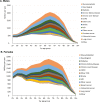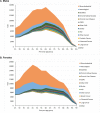Health system costs for individual and comorbid noncommunicable diseases: An analysis of publicly funded health events from New Zealand
- PMID: 30620729
- PMCID: PMC6324792
- DOI: 10.1371/journal.pmed.1002716
Health system costs for individual and comorbid noncommunicable diseases: An analysis of publicly funded health events from New Zealand
Abstract
Background: There is little systematic assessment of how total health expenditure is distributed across diseases and comorbidities. The objective of this study was to use statistical methods to disaggregate all publicly funded health expenditure by disease and comorbidities in order to answer three research questions: (1) What is health expenditure by disease phase for noncommunicable diseases (NCDs) in New Zealand? (2) Is the cost of having two NCDs more or less than that expected given the independent costs of each NCD? (3) How is total health spending disaggregated by NCDs across age and by sex?
Methods and findings: We used linked data for all adult New Zealanders for publicly funded events, including hospitalisation, outpatient, pharmaceutical, laboratory testing, and primary care from 1 July 2007 to 30 June 2014. These data include 18.9 million person-years and $26.4 billion in spending (US$ 2016). We used case definition algorithms to identify if a person had any of six NCDs (cancer, cardiovascular disease [CVD], diabetes, musculoskeletal, neurological, and a chronic lung/liver/kidney [LLK] disease). Indicator variables were used to identify the presence of any of the 15 possible comorbidity pairings of these six NCDs. Regression was used to estimate excess annual health expenditure per person. Cause deletion methods were used to estimate total population expenditure by disease. A majority (59%) of health expenditure was attributable to NCDs. Expenditure due to diseases was generally highest in the year of diagnosis and year of death. A person having two diseases simultaneously generally had greater health expenditure than the expected sum of having the diseases separately, for all 15 comorbidity pairs except the CVD-cancer pair. For example, a 60-64-year-old female with none of the six NCDs had $633 per annum expenditure. If she had both CVD and chronic LLK, additional expenditure for CVD separately was $6,443/$839/$9,225 for the first year of diagnosis/prevalent years/last year of life if dying of CVD; additional expenditure for chronic LLK separately was $6,443/$1,291/$9,051; and the additional comorbidity expenditure of having both CVD and LLK was $2,456 (95% confidence interval [CI] $2,238-$2,674). The pattern was similar for males (e.g., additional comorbidity expenditure for a 60-64-year-old male with CVD and chronic LLK was $2,498 [95% CI $2,264-$2,632]). In addition to this, the excess comorbidity costs for a person with two diseases was greater at younger ages, e.g., excess expenditure for 45-49-year-old males with CVD and chronic LLK was 10 times higher than for 75-79-year-old males and six times higher for females. At the population level, 23.8% of total health expenditure was attributable to higher costs of having one of the 15 comorbidity pairs over and above the six NCDs separately; of the remaining expenditure, CVD accounted for 18.7%, followed by musculoskeletal (16.2%), neurological (14.4%), cancer (14.1%), chronic LLK disease (7.4%), and diabetes (5.5%). Major limitations included incomplete linkage to all costed events (although these were largely non-NCD events) and missing private expenditure.
Conclusions: The costs of having two NCDs simultaneously is typically superadditive, and more so for younger adults. Neurological and musculoskeletal diseases contributed the largest health system costs, in accord with burden of disease studies finding that they contribute large morbidity. Just as burden of disease methodology has advanced the understanding of disease burden, there is a need to create disease-based costing studies that facilitate the disaggregation of health budgets at a national level.
Conflict of interest statement
The authors have declared that no competing interests exist.
Figures




Similar articles
-
A review on Noncommunicable Diseases (NCDs) burden, its socio-economic impact and the strategies for prevention and control of NCDs in India.Indian J Public Health. 2018 Oct-Dec;62(4):302-304. doi: 10.4103/ijph.IJPH_324_16. Indian J Public Health. 2018. PMID: 30539894
-
The macroeconomic burden of noncommunicable diseases associated with air pollution in China.PLoS One. 2019 Apr 18;14(4):e0215663. doi: 10.1371/journal.pone.0215663. eCollection 2019. PLoS One. 2019. PMID: 30998763 Free PMC article.
-
Health Care Costs by Type of Expenditure across eGFR Stages among Patients with and without Diabetes, Cardiovascular Disease, and Heart Failure.J Am Soc Nephrol. 2020 Jul;31(7):1594-1601. doi: 10.1681/ASN.2019121308. Epub 2020 Jun 2. J Am Soc Nephrol. 2020. PMID: 32487562 Free PMC article.
-
The impact of diabetes mellitus on healthcare costs in Italy.Expert Rev Pharmacoecon Outcomes Res. 2011 Dec;11(6):709-19. doi: 10.1586/erp.11.78. Expert Rev Pharmacoecon Outcomes Res. 2011. PMID: 22098288 Review.
-
Projected Costs of Informal Caregiving for Cardiovascular Disease: 2015 to 2035: A Policy Statement From the American Heart Association.Circulation. 2018 May 8;137(19):e558-e577. doi: 10.1161/CIR.0000000000000570. Epub 2018 Apr 9. Circulation. 2018. PMID: 29632217 Review.
Cited by
-
Estimating non-communicable disease treatment costs using probability-based cost estimation.Glob Health Action. 2022 Dec 31;15(1):2008627. doi: 10.1080/16549716.2021.2008627. Glob Health Action. 2022. PMID: 35147492 Free PMC article.
-
Trends in the Incidence of Brain Cancer: An Observational Study.Cureus. 2024 Oct 31;16(10):e72805. doi: 10.7759/cureus.72805. eCollection 2024 Oct. Cureus. 2024. PMID: 39618616 Free PMC article.
-
Disease-specific health spending by age, sex, and type of care in Norway: a national health registry study.BMC Med. 2023 Jun 6;21(1):201. doi: 10.1186/s12916-023-02896-6. BMC Med. 2023. PMID: 37277874 Free PMC article.
-
Economic effects of dietary salt reduction policies for cardiovascular disease prevention in Japan: a simulation study of hypothetical scenarios.Front Nutr. 2023 Nov 9;10:1227303. doi: 10.3389/fnut.2023.1227303. eCollection 2023. Front Nutr. 2023. PMID: 38024379 Free PMC article.
-
Implications of multimorbidity patterns on health care utilisation and quality of life in middle-income countries: cross-sectional analysis.J Glob Health. 2019 Dec;9(2):020413. doi: 10.7189/jogh.09.020413. J Glob Health. 2019. PMID: 31448114 Free PMC article.
References
-
- Murray CJL, Lopez AD. Measuring global health: motivation and evolution of the Global Burden of Disease Study. The Lancet. 2017;390(10100):1460–4. - PubMed
-
- OECD. Expenditure by disease, age and gender—focus on health spending Paris: OECD, 2016.
Publication types
MeSH terms
LinkOut - more resources
Full Text Sources

